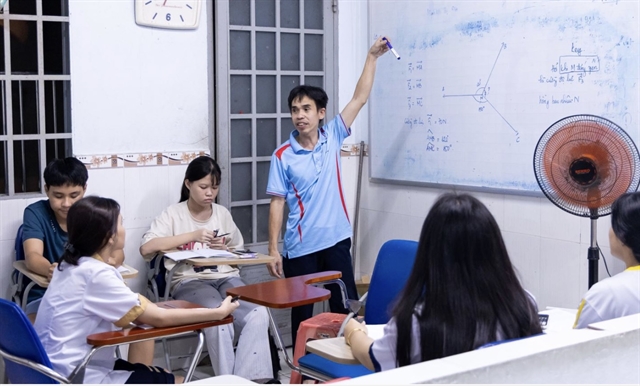 Society
Society

Increased number of personal vehicles, limited bus stops and unattractive ticket prices made bus passengers decreased during the past years, said transport experts.
 |
| A bus picks up passengers at Cầu Giấy Bus Stop. An inadequate number of bus stops is blamed for a decreased number of passengers in Hà Nội. — VNA/VNS Photo Huy Hùng |
HÀ NỘI — Increased numbers of personal vehicles, limited bus stops and unattractive ticket prices have brought down the number of bus passengers in the past few years, transport experts said.
In 2014 nearly 470 million people used buses, but last year the service received only about 430 million people. And in the first seven months of this year, the amount of bus passengers decreased by 9.5 per cent compared with the same period last year.
Nguyễn Công Nhật, deputy director of the Hà Nội Transport and Services Corporation, said that the city now has more than 1,500 buses, 2,200 bus stops and 1.3km of roads for buses only.
Nhật blamed the decrease on the city’s inadequate number of bus tops. Bus stops are too far from each other, he said. On average, each stop is a distance of roughly 700-800m from the next closest stop.
Bus stop locations have proved contentious; several small traders have refused to allow stops at their stores, afraid a bus stop would affect their trading.
Another problem is rooted in the workforce: about 5-10 years ago, many people queued up to apply for a job as bus driver, but now few people want to do the work, Nhật said.
“Bus drivers must work continuously 8-9 hours per day. Moreover, they must share the road with other vehicles, so they need strong nerves,” he said.
Trần Hữu Minh, deputy chief of the National Traffic Safety Committee Secretariat, said that as personal vehicles developed quickly, congestion slowed buses down to the point that they travel no quicker than bicycles.
Personal income also increased, so a person can buy a motorbike with their salary in two or three months, making a cheap bus ticket less attractive than before, he said. Now, for instance, students can often purchase motorbike soon after graduation.
In addition, bus infrastructure is often unsafe and encroached by other vehicles, he said.
Simply put, it seems buses cannot compete with personal vehicles in terms of convenience, travel time and flexibility.
Khuất Việt Hùng, Standing Deputy Chairman of the National Traffic Safety Committee, said that if Hà Nội wishes to develop its urban bus system, it needs to make the project a priority.
Walking areas should be tidied up so that pedestrians more easily access bus stops, he said.
Bus also need more priority road space to move efficiently through their route.
Coaches, taxies and personal vehicles encroaching bus stops must be punished strictly, said Hùng.
Deputy director Nguyễn Công Nhật said that buses should be equipped with handy services such as free-of-charge wifi and a smart loudspeaker to inform passengers about bus routes and stops.
Nguyễn Thanh Tú, a lecturer from the Hà Nội University of Transport, suggested establishing bus routes in new residential quarters, and at more shopping malls and leisure centres, to attract more passengers. — VNS




